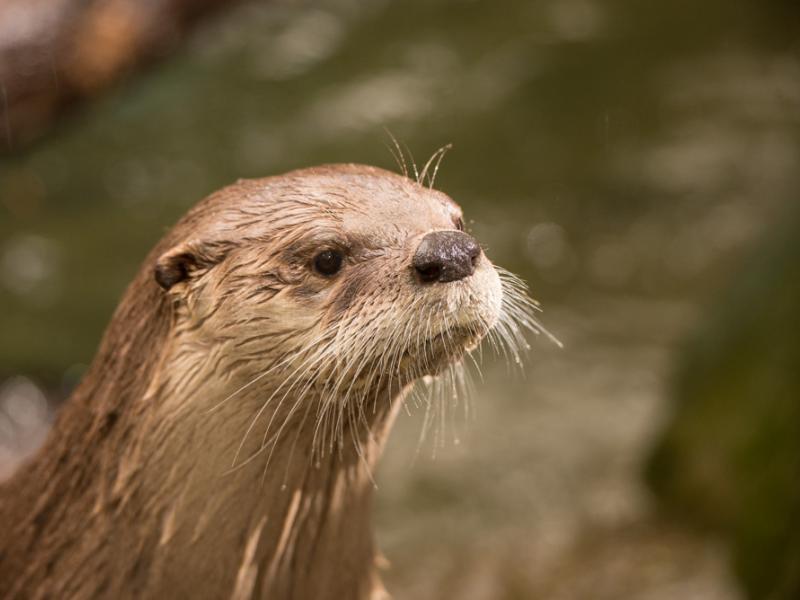Egg-cellent! Zoo welcomes first condor chicks of 2018

With two new chicks and nine eggs, Oregon Zoo condors are on track for a great year
Two pairs of proud California condor parents welcomed new chicks at the Oregon Zoo's Jonsson Center for Wildlife Conservation yesterday, kicking off what looks to be great year for the condor recovery effort.
Since late January, condors at the offsite facility have been laying the groundwork for species recovery one egg at a time. The condors laid nine eggs this year, with seven confirmed to be fertile. Two have hatched, and the rest are expected to arrive in the coming weeks.
"Each new egg is critical to the California condor's comeback," said Kelli Walker, the zoo's lead condor keeper.
Among the expecting condor parents this year is No. 348, known as Willie, and his mate No. 155, known as Timocho. The pair has raised chicks together before, including "re-hatched" offspring (originally incubated by other birds).
"Willie loves his chicks," Walker said. "I have never seen a bird get so excited as Willie when he hears a hatching chick. Last year, when Willie and Timocho were down eating and Willie heard the chick, he spun around in a circle on his toes with excitement, flew up to the nest room and settled on it immediately."
Condor parents take turns brooding their chicks, Walker said, and the chicks will stay with their parents for at least eight months before moving to the Jonsson Center's pre-release pens for about a year and a half. Eventually, they will travel to a wild release site to join free-flying condors in California, Arizona or Baja Mexico. With so few of the birds left in the world, each new chick is vitally important to the species' survival.
The California condor was one of the original animals included on the 1973 Endangered Species Act and is classified as critically endangered. In 1982, only 22 individuals remained in the wild and by 1987, the last condors were taken into captivity in an attempt to save the species from extinction. Thanks to breeding programs like the Oregon Zoo's, condor numbers now total around 450, with the majority of those flying free and breeding in the wild.
Since 2003, 63 chicks have hatched at the Jonsson Center, and 47 Oregon Zoo-reared birds have gone out to field pens for release. In addition, several eggs laid by Oregon Zoo condors have been placed in wild nests to hatch. Staff hope the 2018 breeding season will provide another boost to those totals.
Condors are the largest land birds in North America with wingspans of up to 10 feet and an average weight of 18 to 25 pounds. They are highly intelligent and inquisitive, and they require a tremendous amount of parental investment in the wild.
The California condor had a long history in Oregon. Lewis and Clark saw the large birds as they traveled along the Columbia River. Local archaeologists have unearthed 9,000-year-old condor bones from Native American middens, and condors were a common motif for the designs of Oregon's Wasco people, who lived along the Columbia River between The Dalles and Cascade Locks.
Accumulated lead poisoning — a problem that plagues all raptors and scavengers — is the most severe obstacle to the California condor's recovery as a species. As the birds feed on carrion and other animal carcasses, they can unintentionally ingest lead from bullet fragments. Lead consumption causes paralysis of the digestive tract and results in a slow death by starvation. Lead also causes severe neurological problems, so the birds not only starve but also suffer from impaired motor functions.
Through its Non-Lead Hunting Education Program, the Oregon Zoo aims to inspire hunters — traditionally some of the strongest supporters of wildlife and habitat conservation — to continue that legacy by choosing non-lead ammunition.
The Oregon Zoo's condor recovery efforts take place at the Jonsson Center for Wildlife Conservation, located in rural Clackamas County on Metro-owned open land. The remoteness of the facility minimizes the exposure of young condors to people, increasing the chances for captive-hatched birds to survive and breed in the wild.
California condor breeding programs are also operated at San Diego Zoo's Wild Animal Park, the Los Angeles Zoo and the Peregrine Fund's World Center for Birds of Prey in Idaho. LightHawk, a nonprofit conservation flying organization, also provides support for these condor-recovery efforts.
More News

Zoo says goodbye to Tilly, beloved otter mom
At 16, Tilly was considered geriatric for her species.April 30, 2025

Rescued cougar cubs are venturing out
A pair of orphaned cougar cubs, rescued and brought to the zoo by Washington Department of Fish and Wildlife staff in November, have begun exploring their outdoor habitat.April 17, 2025

Zoo seeks pika watchers for summer season
The Oregon Zoo is recruiting volunteers for Cascades Pika Watch.April 15, 2025

